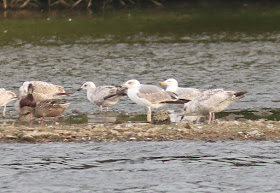Bar-tailed Godwits, Knot and a Sanderling
Only one adult male summer Bar-tailed Godwit in a flock of 64 birds- perhaps its a non-breeding flock or a flock dominated by females still heading north (females winter further south than males so could travel north later than males?). There was also a presumed non-breeding flock of Black-tailed Godwits at Oare which often summer at Oare and don't bother migrating to Iceland. First-summer and non-breeding waders notoriously create semi-resident or limited migratory groups- only migrating part of the way to the breeding grounds. The Knots were also in non-breeding plumage suggesting this group of birds are in no rush to get to the breeding grounds. Barwits winter from north-west Europe to west Africa (there were large number in Dakhla Bay, Western Sahara when we visited HERE). According to the migration atlas birds that winter in the UK breed in Northern Europe and Western Siberia and the birds that winter further south and migrate through the UK in Spring are heading to the Siberian Taimyr and Yamal peninsulas. There is generally a month between the UK breeders leaving and the African migrants arriving. Both populations head to the Wadden Sea before they fatten up to continue further north or east east. Unlike Dunlin where the UK wintering population (alpina) and the migratory population (schinzii) are taxonomically different, in Barwit its the same sub-species. Our Barwits are of the nominate lapponica which differ from the Asian sub-species baureri, one of the main characteristics of nominate is the clean white underwings (barred on the Asian race). Barwits are famous for completing long range, non-stop migrations.
The only Whimbrel of the day
Female Marsh Harrier, extensive cream on this bird, presumably an older bird
A Grey Seal battling the white horses on the rough Swale
A second-summer Yellow-legged Gull at Sevenoaks.
It was my first visit to Sevenoaks reserve, which is an impressive inland site. Over 200 hirundines were hawking low over the water this evening presumably keeping out of the wind








No comments:
Post a Comment